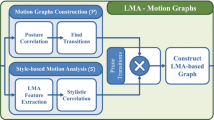Abstract
In this paper, we propose a novel approach to generating a sequence of dance motions using music similarity as a criterion to find the appropriate motions given a new musical input. Based on the observation that dance motions used in similar musical pieces can be a good reference in choreographing a new dance, we first construct a music-motion database that comprises a number of segment-wise music-motion pairs. When a new musical input is given, it is divided into short segments and for each segment our system suggests the dance motion candidates by finding from the database the music cluster that is most similar to the input. After a user selects the best motion segment, we perform music-dance synchronization by means of cross-correlation between the two music segments using the novelty functions as an input. We evaluate our system’s performance using a user study, and the results show that the dance motion sequence generated by our system achieves significantly higher ratings than the one generated randomly.







Similar content being viewed by others
Notes
In order to show the effect of music-motion synchronization, two video clips before and after synchronization are exemplified for comparison. The video clips can be found at http://plaza4.snu.ac.kr/~park73/download/DMGS.html.
The video clips can be found at http://plaza4.snu.ac.kr/~park73/download/DMGS.html.
References
Alankus G, Bayazit AA, Bayazit OB (2005) Automated motion synthesis for dancing characters. Comput Animat Virt W 16(3–4):259–271
Bartsch MA, Wakefield GH (2001) To catch a chorus: using chroma-based representations for audio thumbnailing. In: 2001 IEEE workshop on the applications of signal processing to audio and acoustics, pp 15–18
Foote J (1999) Visualizing music and audio using self-similarity. In: Proc. ACM multimedia, pp 70–80
Foote J (2000) Automatic audio segmentation using a measure of audio novelty. In: Proc. IEEE int. conf. multimedia and expo (ICME2000), vol 1, pp 452–455
Gray JM (1975) An exploration of musical timbre. PhD thesis, Dept. of Psychology, Stanford University, Stanford, CA, USA (1975)
Grunberg D, Ellenberg R, Kim Y, Oh P (2009) Creating an autonomous dancing robot. In: Proceedings of the international conference on hybrid information technology (ICHIT), pp 221–227
Ikeuchi K, Shiratori T, Nakazawa A (2006) Dancing-to-music character animation. Comput Graph Forum 25:449–458
Kang K-K, Kim D (2007) Synthesis of dancing character motion from beatboxing sounds, smart graphics. In: Lecture notes in computer science, vol 4569. Springer, Berlin, pp 216–219
Kanungo T, Netanyahu NS, Wu AY (2002) An efficient k-means clustering algorithm: analysis and implementation. IEEE Trans Pattern Anal Mach Intell 24(7):881–892
Kim JW, Fouad H, Sibert JL, Hahn JK (2009) Perceptually motivated automatic dance motion generation for music. Comput Animat Virt W 20:375–384
Likas A, Vlassis N, Verbeek JJ (2003) The global k-means clustering algorithm. Pattern Recogn 36(2):451–461
Loi K-C, Li T-Y (2009) Automatic generation of character animations expressing music features. In: Proceedings of the APSIPA annual summit and conference, pp 216–221
Nakahara N, Miyazaki K, Sakamoto H, Fujisawa TX, Nagata N, Nakatsu R (2009) Dance motion control of a humanoid robot based on real-time tempo tracking from musical audio signals. In: Entertainment computing—ICEC 2009, lecture notes in computer science, vol 5709. Springer, Berlin, pp 36–47
Nakaoka S, Kajita S, Yokoi K (2010) Intuitive and flexible user interface for creating whole body motions of biped humanoid robots. In: IEEE/RSJ international conference on intelligent robots and systems (IROS), pp 1675–1682
Ofli F, Erzin E, Yemez Y, Tekalp AM (2010) Multi-modal analysis of dance performances for music-driven choreography synthesis. In: Proc. IEEE international conference on acoustics speech and signal processing (ICASSP), pp 2466–2469
Sandholm A, Pronost N, Thalmann D (2009) MotionLab: a Matlab toolbox for extracting and processing experimental motion capture data for neuromuscular simulations. In: Modelling the physiological human—lecture notes in computer science, vol 5903, pp 110–124
Sauer D, Yang Y-H (2009) Music-driven character animation. ACM T Multim Comput 5(4):1–16
Shiratori T, Ikeuchi K (2008) Synthesis of dance performance based on analyses of human motion and music. Inf Process Soc JPN 1:80–93
Taylor GW, Hinton GE, Roweis ST (2007) Modeling human motion using binary latent variables. In: Advances in neural information processing systems, vol 19, pp 1345–1352
Acknowledgements
This study was supported by the grant (No. 2011-P3-15) of Advanced Institutes of Convergence Technology (AICT). Also, we greatly acknowledge Dr. Junghoon Kwon for his help on the use of the motion capture system.
Author information
Authors and Affiliations
Corresponding authors
Additional information
Kyogu Lee and Jaeheung Park are the corresponding authors.
Rights and permissions
About this article
Cite this article
Lee, M., Lee, K. & Park, J. Music similarity-based approach to generating dance motion sequence. Multimed Tools Appl 62, 895–912 (2013). https://doi.org/10.1007/s11042-012-1288-5
Published:
Issue Date:
DOI: https://doi.org/10.1007/s11042-012-1288-5




